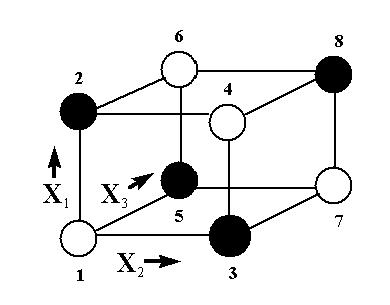5.
Process Improvement
5.3.
Choosing an experimental design
5.3.3.
How do you select an experimental design?
5.3.3.3.
Full factorial designs
5.3.3.3.3.
|
Blocking of full factorial designs
|
|
|
Eliminate the influence of extraneous factors by "blocking"
|
We often need to eliminate the influence of extraneous factors
when running an experiment. We do this by "blocking".
Previously, blocking was introduced when randomized
block designs were discussed. There we were concerned with one
factor in the presence of one of more nuisance factors. In this section
we look at a general approach that enables us to divide 2-level
factorial experiments into blocks.
For example, assume we anticipate predictable shifts will occur while
an experiment is being run. This might happen when one has to change to
a new batch of raw materials halfway through the experiment. The effect
of the change in raw materials is well known, and we want to eliminate
its influence on the subsequent data analysis.
|
|
Blocking in a 23 factorial design
|
In this case, we need to divide our experiment into two halves (2
blocks), one with the first raw material batch and the other
with the new batch. The division has to balance out the effect of the
materials change in such a way as to eliminate its influence on the
analysis, and we do this by
blocking.
|
|
Example
|
Example: An eight-run 23 full factorial has to be
blocked into two groups of four runs each. Consider the design
`box' for the 23 full factorial. Blocking can be achieved
by assigning the first block to the dark-shaded corners and the second
block to the open circle corners.
|
|
Graphical representation of blocking scheme
|
FIGURE 3.3 Blocking Scheme for a 23 Using Alternate
Corners

|
|
Three-factor interaction confounded with the block effect
|
This works because we are in fact assigning the `estimation' of the
(unwanted) blocking effect to the three-factor interaction, and
because of the special property of two-level designs called
orthogonality.
That is, the three-factor interaction is "confounded" with the
block effect as will be seen shortly.
|
|
Orthogonality
|
Orthogonality guarantees that we can always estimate the effect of one
factor or interaction clear of any influence due to any other factor or
interaction. Orthogonality is a very desirable property in DOE and this
is a major reason why two-level factorials are so popular and successful.
|
|
Table showing blocking scheme
|
Formally, consider the 23 design table with the three-factor
interaction column added.
TABLE 3.10 Two Blocks for a 23 Design
SPEED
X1
|
FEED
X2
|
DEPTH
X3
|
X1*X2*X3
|
BLOCK
|
|
-1
|
-1
|
-1
|
-1
|
I
|
|
+1
|
-1
|
-1
|
+1
|
II
|
|
-1
|
+1
|
-1
|
+1
|
II
|
|
+1
|
+1
|
-1
|
-1
|
I
|
|
-1
|
-1
|
+1
|
+1
|
II
|
|
+1
|
-1
|
+1
|
-1
|
I
|
|
-1
|
+1
|
+1
|
-1
|
I
|
|
+1
|
+1
|
+1
|
+1
|
II
|
|
|
Block by assigning the "Block effect" to a high-order interaction
|
Rows that have a `-1' in the three-factor interaction column are
assigned to `Block I' (rows 1, 4, 6, 7), while the other rows are
assigned to `Block II' (rows 2, 3, 5, 8). Note that the Block I rows
are the open circle corners of the design `box' above; Block II are
dark-shaded corners.
|
|
Most DOE software will do blocking for you
|
The general rule for blocking is: use one or a combination of high-order
interaction columns to construct blocks. This gives us a formal way of
blocking complex designs. Apart from simple cases in which you can
design your own blocks, your statistical/DOE software will do the
blocking if asked, but you do need to understand the principle behind it.
|
Block effects are confounded with higher-
order interactions
|
The price you pay for blocking by using high-order interaction columns
is that you can no longer distinguish the high-order interaction(s)
from the blocking effect - they have been
`confounded,' or
`aliased.' In fact, the
blocking effect is now the sum of the blocking effect and the high-order
interaction effect. This is fine as long as our assumption about
negligible high-order interactions holds true, which it usually does.
|
|
Center points within a block
|
Within a block, center point runs are assigned as if the block were
a separate experiment - which in a sense it is.
Randomization
takes place within a block as it would for any non-blocked DOE.
|


